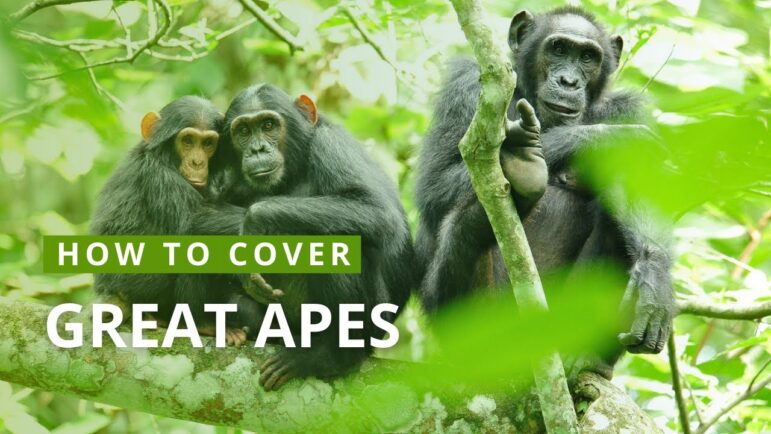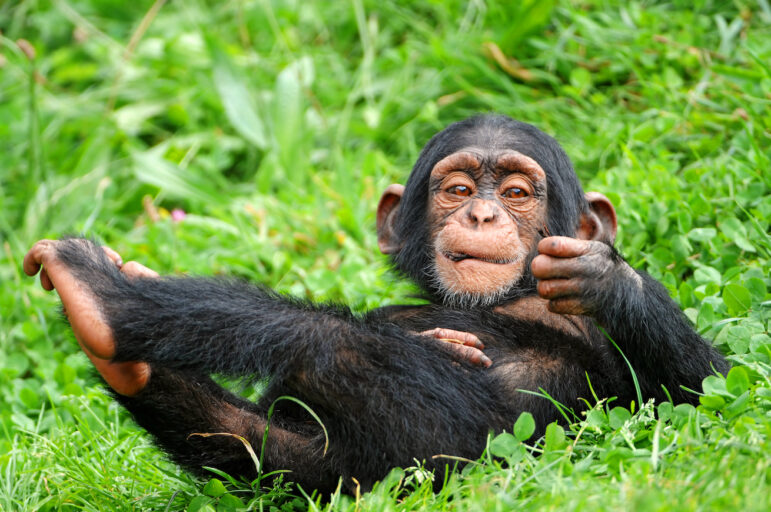
Baby chimp by Flickr user Tambako The Jaguar (CC BY-ND 2.0).
For the past decade, Mongabay has contributed an influential voice to biodiversity conservation, with in-depth journalism about the clade of apes, including orangutans, gibbons, gorillas, chimpanzees, and bonobos. Our dedication to disseminating accurate independent journalism has not only reached millions of readers globally but has also contributed to real-world impacts by informing audience actions.
In this report, we reflect on our decade covering apes, the threats they face, and the impact Mongabay’s journalism has had. Our coverage spans the majority of the geographic range of ape species, with articles coming from 23 countries across Africa (Cameroon, Central African Republic, Côte d’Ivoire, Democratic Republic of Congo, Equatorial Guinea, Ghana, Guinea,Guinea-Bissau, Liberia, Mali, Nigeria, Rwanda, Senegal, Sierra Leone, Tanzania, Uganda, Zambia) and Asia (Cambodia, China, India, Indonesia, Malaysia, Thailand). We worked with over 90 journalists to publish more than 800 articles. As a result, these articles attracted over 2 million readers who collectively spent 825 days reading our coverage.
The diversity of themes featured in reflect the breadth of Mongabay’s reporting on apes. Mongabay produced extensive coverage relevant to extractive industries and ape conservation. For example, a report on how the demand for electronic devices can undermine gorilla habitats brought the struggle between technological progress and conservation to the fore by pointing out the importance of recycling in reducing the demand for minerals mined in these sensitive areas. Another notable article highlighted how a bauxite mining boom in Guinea’s Boké region threatens the habitats of critically endangered western chimpanzees, driving them closer to extinction. A video offers a compelling view of how mining operations are driving chimpanzees from their habitat.These reports are emblematic of the broader narrative on how extractive industries impact ape conservation.
Industrial agriculture and ape conservation is another area where Mongabay’s reporting shines. For instance, we published articles on deforestation’s threat to orangutans and the role of plantation agriculture and global demand for palm oil in putting pressure on these Southeast Asian apes. This theme was also included in coverage of the agricultural pressures on gorilla populations and the threat of logging to tool-wielding chimpanzees populations in Cameroon.
Mongabay also provides several articles on how infrastructural development influences ape habitats. In Asia, gibbons feel the impacts of fragmentation due to railways, which separate populations. We also reported on the theme of ‘Killing, Capture, Trade and Conservation,’ as evidenced by articles such as those on the grim reality of bonobo trafficking and the story of chimpanzee kidnapping.
Each of these subject areas uncovers different aspects of the myriad challenges apes face. In addition to increasing public awareness, Mongabay’s nonprofit journalism over the past ten years has been a catalyst for greater transparency. By disseminating crucial information, we’ve empowered people to make informed decisions regarding ape conservation and to hold governments and industries to account for their impacts. Mongabay continues to report on threats to these species and serve an audience of decision-makers with reliable journalism based on scientific findings and on-the ground research.
The ripple effect of environmental journalism
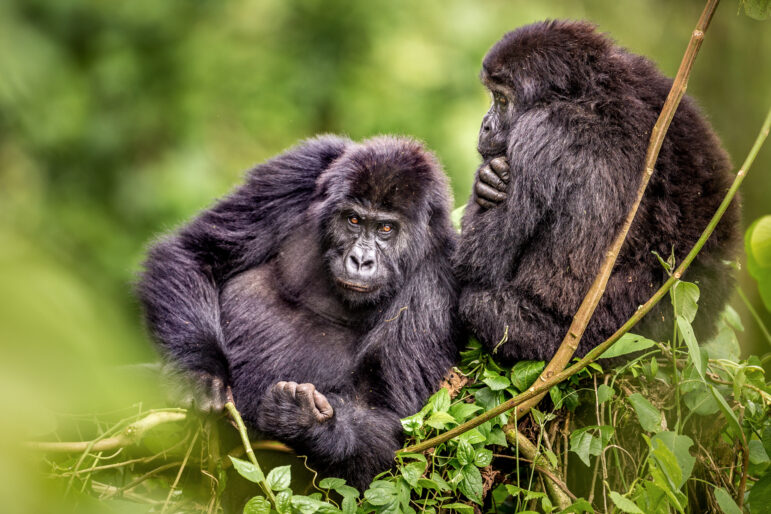
Two Grauer’s gorillas in Kahuzi-Biega National Park, DR Congo. Grauer’s gorillas are the world’s largest primates, and highly threatened, their population having declined close to 80% in just a few decades. Image by Marcus Westberg.
Beyond Mongabay’s channels, our original reporting on apes spread thousands of times via hundreds of relevant organizations and activists, such as Greenpeace, US Mission to ASEAN, Indigenous Environmental Network, Shareholders Unite, London Mining Network, Burma Rivers Network, Natural Capital Project, London Stock Exchange, Apollo Investments, Think Geoenergy, BankTrack, Jatam, Conservation International, Environmental Investigation Agency, Green Indonesia, Indo-Pacific Monitor, Mission Blue, NewsOnGreen, Rainforest Action Network, Solar Networks, MBARI, Orangutan Outreach, Orangutan Land Trust, International Rivers, Blue Planet Society, World Resources Institute, Borneo Nature Foundation, HAkA, CGIAR, The Borneo Project, 350.org Indonesia, UN Convention on Biological Diversity, RIMBA Research, and Alert-Conservation.
Likewise, the articles were republished and cited by other media outlets. Each time Mongabay articles are republished, our stories become a part of a wider dialogue, informing and shaping perspectives on conservation across geographical boundaries. These outlets include but are not limited to The Guardian, Southeast Asia Globe, National Geographic, Vientiane Times, Mekong Eye, the Mining Hub, Pacific Standard Magazine, Eco-Business, Redd-Monitor, L’Important, HydroWorld, Environmental Health News, Truth Out, MSN, Asia Times, Intellasia, Daily Maverick, Asian Correspondent, Green Energy Times, Cambodia,org, Focusing on Wildlife, Medium, IBTimes, Bougainville News, Indonesia Expat, Clean Malaysia, The News Lens, Daily Climate, West Papua Media, and Coconuts.
What’s more, Mongabay’s news about threats to the Tapanuli orangutan also reverberated across the media. Filmmaker Matt Senior attributed his interest in the species to a Mongabay article, leading to him producing a documentary about the rare species and its ecosystem. The film Now Or Never has continued to win awards and gain traction at film festivals worldwide, demonstrating the real-world impact of our journalism’s reach.
Orangutans
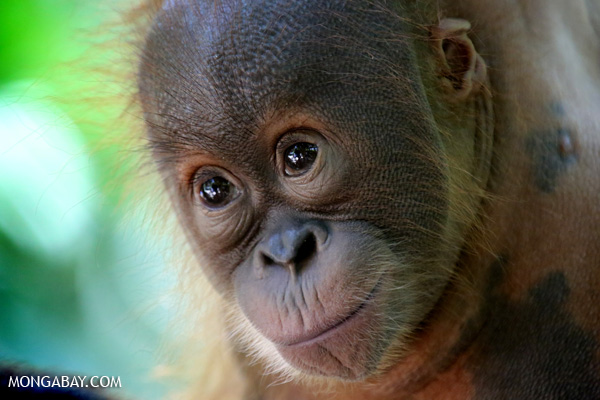
A baby orangutan in Indonesia’s North Sumatra province. Image by Rhett A. Butler/Mongabay.
With well over 580 articles published over the last decade, Mongabay is at the forefront of bringing worldwide attention to the dire situation of orangutans. This sustained in-depth exploration provides the context behind individual stories, such as the record deforestation in Sumatra and the toll of deforestation in Borneo, to offer a unique perspective on the escalating crisis. An understanding of these trends enabled Mongabay to scrutinize and communicate diverse threats to orangutans, be it from non-palm oil plantations, the illegal wildlife trade, industrial or the brands linked to habitat loss. Simultaneously, these stories engage with complex subjects, including the controversy over the official orangutan data in Indonesia and investigating the efficiency of conservation funding. These articles represent just a fraction of Mongabay’s extensive coverage, reflecting their commitment to shedding light on every aspect of orangutan conservation including studies of orangutan behavior, climate-resilient habitat composition, and disease risks.
discussed the three critically endangered species of orangutan and Mongabay brought unparalleled attention to the Tapanuli orangutan in particular. Today, fewer than 800 apes inhabit a single site, the Batang Toru forest in North Sumatra. Mongabay’s reporting allowed readers to follow the rapidly unfolding events in the race to develop or save the Tapanuli’s habitat. This consistent coverage yielded a wide variety of impacts.
Mongabay’s initial 2018 article about the Tapanuli orangutan analyzed the findings from a study by Dr. William F. Laurance called for “urgent habitat protection” in northern Sumatra. The Irish Independent’s coverage of a related Associated Press story prominently featured a tweet from the orangutan researcher Serge Wich about the Mongabay article, which was likewise carried in the UK by the Daily Mail, and the Guernsey Press. Science News Daily and other news aggregators also picked it up. In May 2018, the study – along with its public dissemination through media coverage – later prompted 25 of the world’s top environmental scientists to send a letter to Indonesia’s president seeking to halt the hydroelectric project and stop the destruction of the only known habitat of the Tapanuli orangutan.
Our subsequent feature reporting on a controversial hydropower project within the Tapanuli’s only known habitat allowed a researcher to make his public claim that his signature was forged to obtain a permit for the project. The Institute of Nonprofit News recognized this original reporting as part of their 2019 Best of Nonprofit News list. Though this allegation is part of a now rejected lawsuit brought to revoke the environmental permit issued, following Mongabay’s article and coordinated protests outside Bank of China branches and Chinese diplomatic missions in cities including Jakarta, New York, Hong Kong, Manila and Johannesburg, the Bank of China announced it would reconsider its financial support of the $1.6 billion hydropower project.
In April 2019, Mongabay publicized the International Union for Conservation of Nature’s (IUCN) call to halt all projects that threaten the rare species. Although the IUCN’s statement didn’t directly mention the hydroelectric plant and dam in the Batang Toru ecosystem, it requested the cease to allow time to formulate a plan to save the Tapanuli orangutan. As a result, in July 2020, the government official from state-owned utility PLN who oversees the project told Mongabay the funding from the Bank of China had paused “due to environmental concerns as well as COVID-19,” and the project is now delayed by three years from its initial operation date in 2022 to 2025.
Apart from these impacts, Mongabay published several in-depth reports and videos that garnered high engagement among target audiences, such as:
- New Species of orangutan threatened from moment of its discovery
- Facebook video shows orangutan defending forest against bulldozer
- What is happening to the orangutans of Borneo?
- Palm oil deforestation hits record high in Sumatra’s ‘orangutan capital’
- Video: Fight for survival: The battle to save the last Tapanuli orangutans
Gorillas
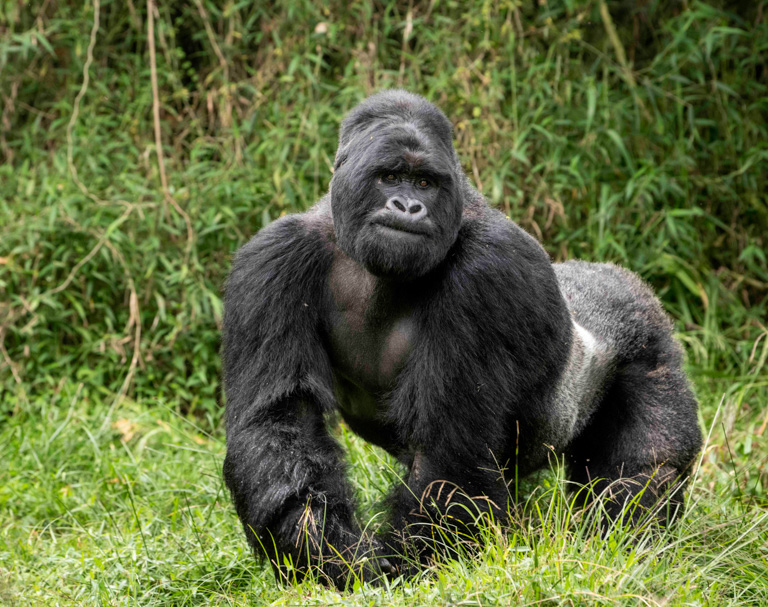
A silverback mountain gorilla in Uganda. Image by Skyler Bishop/Gorilla Doctors.
Mongabay always strives to shed light on stories that are overlooked by mainstream media. Our reporting on gorillas often resonated with the most readership when focusing on solutions and illuminating obscure issues that are challenging to report. For example, Mongabay’s publications on gorilla conservation included a 2019 census in eastern Africa that revealed a promising increase in mountain gorilla numbers, shedding light on the impact of concerted conservation initiatives. Mongabay’s coverage of the transformation in the Mbe Mountains was another inspiring story. Bushmeat hunters had become protectors of the Cross River gorillas, which resonated deeply within the region. Following publication, the U.S. Ambassador to Nigeria wrote to Mongabay in response to the article: “You have truly inspired with the light you cast on the people whose actions and wisdom preserve the wonder of the Cross River gorilla. You remind us that in conservation there is both a worthwhile purpose and the prospect of economic opportunity.”
Our gorilla coverage over the past decade has catalyzed many real-world impacts, contributing to the awareness and conservation of these creatures. In 2019, Mongabay explored the complex drivers of the illicit trade of ape body parts in Nigeria. A video accompanied the article that unfolded new findings and painted a picture of the trade as an intricate, well-coordinated, and profitable operation rather than a mere byproduct of the more extensive bushmeat trade. The story gave insight into the lucrative trade and a greater understanding of the cultural and spiritual beliefs surrounding ape body parts. The investigation arose from a recognition that filling known information gaps on this trade could lead to better informed actions at the core of Mongabay’s impacts. During pre-publication review of the State of the Apes book series, Mongabay noted that our articles were being cited as evidence as a result of a sectoral knowledge gap on the ape parts trade.
Also in Nigeria, a video from the Mbe Mountains provided a glimpse into the lives of Cross River gorillas, including rare footage of baby gorillas. Furthermore, an episode in the Chasing Deforestation video series provided an in-depth examination of the efforts to protect this species and the role of poverty alleviation for successful conservation. This theme was also evident in Mongabay’s coverage of the Wildlife Conservation Society’s (WCS) radio program “My Gorilla My Community”. Mongabay highlighted the program’s ability to connect with rural communities and change perspectives on conservation in the report. “The program helps us understand our forest and the animals there and teaches us why we need to keep them,” said smallholder farmer Anthony Okwo. In most rural communities across Nigeria, radio remains an effective tool for educating, informing, and entertaining the people, explained Linus Unah, Mongabay correspondent. “By drawing on communities’ oral traditions, history, music, and everyday life, ‘My Gorilla My Community’ strikes a chord with listeners,” he said. Highlighting success stories, such as WCS’s radio programs, can lead to transformative change by providing blueprints and case studies for effective models: NGOs spread best practices, philanthropists and the public sector better understand what approaches to support, and communities learn from each other.
Chimpanzees and gibbons
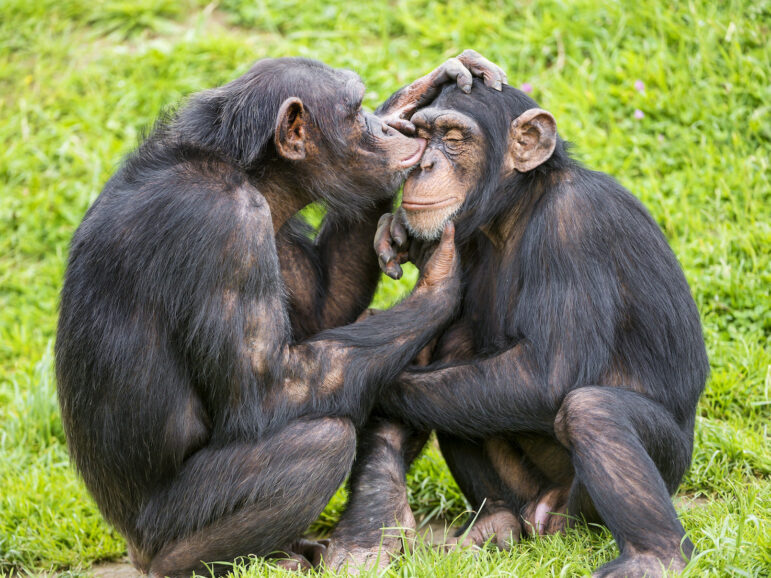
Young male chimpanzees, photographed here at a zoo in Switzerland. Image by Tambako The Jaguar via Flickr (CC BY-ND 2.0).
Within Africa, chimpanzees were well represented in Mongabay’s coverage. A noteworthy impact was when Predictive Discovery Ltd, an Australian mining company, lost $150 million in market capitalization – more than a third of the company’s value – the day it disclosed it was the subject of “a pending media report questioning the legality” of a prospective mining operation in Guinea.
That media report is the Mongabay investigation, “In Guinea, an illegal $6b gold ‘bonanza’ threatens endangered chimpanzees.” We found that the company’s exploration was taking place inside the boundaries of Haut Niger National Park, violating the law establishing the protected area. The park is home to an estimated 500 western chimpanzees, one of the highest concentrations of the critically endangered primate in West Africa. The BBC learned of Mongabay’s report and interviewed Predictive Discovery’s Managing Director, Paul Roberts, about the situation on BBC Newsday, their global daily live news program. An outcome of this project is this direct pressure on extractive industries companies to increase the transparency of their dealings and address their impact on ape habitat.
In September 2022, Mongabay launched a news bulletin series entitled “Trafficked” to provide short updates about the illegal wildlife trade in Africa. The first installment reported about the armed kidnapping of three young chimpanzees from a sanctuary in the DRC. This news quickly spread worldwide after subsequent coverage was published by The Independent, The Telegraph, The New York Times, HuffPost, Daily Mail, and Al Arabiya. Unfortunately, the perpetrators did not return the abducted chimpanzees. Following the incident, J.A.C.K. Primate Rehabilitation Centre received new funding for surveillance equipment to improve its operational security.
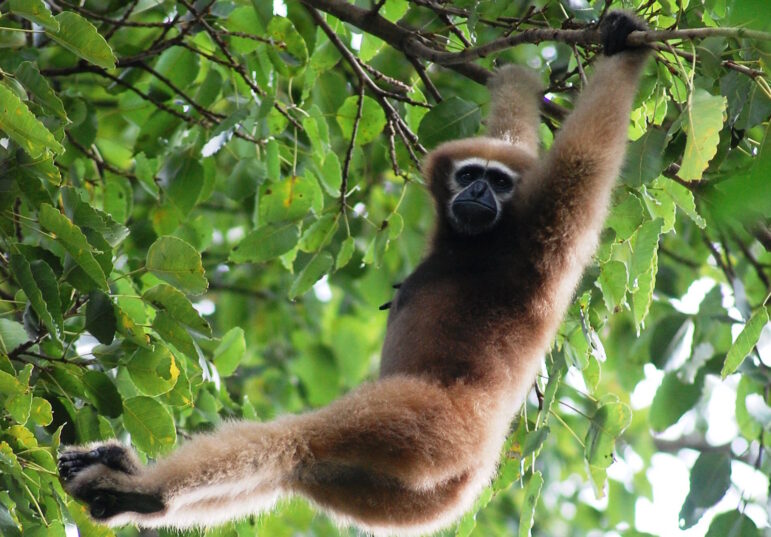
Female Hoolock, Meghalaya. Image by Programme HURO via Wikimedia Commons (CC-BY-3.0).
Mongabay’s work on hoolock gibbons, which consist of three threatened species spread across four countries–Myanmar, India, Bangladesh and China–had a particularly big impact. After highlighting community conservation initiatives in India and scientific findings clarifying their taxonomic status, in 2021, Mongabay published a story on the relationship between forest loss and the decline of the apes. Prominent American actor and environmentalist Leonardo DiCaprio shared this last story on his Instagram, which boasted 52.6 million followers at the time.
The detailed coverage of the financial mechanics behind ape trafficking attracted substantial attention. The Jane Goodall Institute posted Mongabay’s coverage of the finances behind great ape trafficking on its social media page. It prompted this feedback from François Maes, a member of the French office of the Jane Goodall Institute: “We found this article to be a great source of information, detailing the root causes of the trafficking of ape parts and the difficulties which still prevent effective anti-poaching action.”
Empowering journalists to cover apes
Mongabay has played a pivotal role in equipping journalists with the resources and skills necessary to bring the plight of apes to the forefront of public consciousness. Over the last decade, Mongabay has worked with over 90 journalists from across the network to deliver the original stories highlighted in this report.
Mongabay’s effort to report on apes presented an opportunity to enhance local journalism and generate wider recognition of reporters, especially in Africa, where most ape species live. This collaboration allowed Mongabay’s editors to develop a team of reporters with the skills, knowledge and inspiration to continue to tell the stories of the region’s apes. After being dubbed Reporter of the Month, reporter Linus Unah noted his work with Mongabay in an interview with IJNet. Celebrated for his extensive reporting on health, conflict, and development, Unah highlighted the instrumental role Mongabay played in his environmental journalism career. Despite facing challenging conditions, Unah underscored his commitment to amplifying under-reported narratives like the ones at Mongabay.
Providing professional opportunities for journalists to report on ape conservation is a vital contribution to Mongabay’s commitment to capacity building. To extend this core effort to support more journalists, Mongabay organized a webinar entitled, How to Cover Great Apes, featuring a panel of notable experts exploring global and localized threats to ape species and how journalists can better cover them.
The group included:
- Dr. Gladys Kalema-Zikusoka – Founder & CEO of Conservation Through Public Health
- Linus Unah – Journalist from UC Berkeley Graduate School of Journalism
- Prof. Erik Meijaard – from the University of Queensland
Support independent environmental journalism
If you are interested in helping shed light on conservation stories such as this one, there are two excellent ways you can do so with Mongabay. First, consider making a donation, which directly helps us continue to produce high-impact journalism from nature’s frontline. Second, subscribe to Mongabay’s newsletter to get the latest environmental news delivered right to your inbox.
About Mongabay
Mongabay is a nonprofit environmental science and conservation news platform focused on providing cutting-edge independent journalism from nature’s frontline. We pride ourselves on producing reporting that has substantial, tangible impacts around the world.
